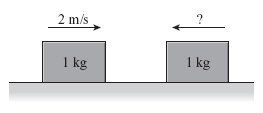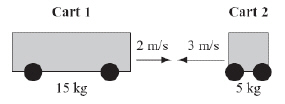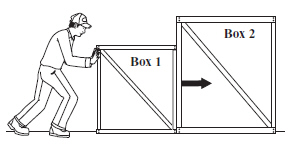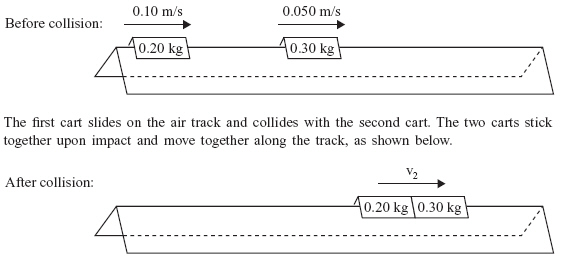Multiple Choice
Identify the
choice that best completes the statement or answers the question.
|
|
|
1.
|
Which of the following has the least momentum? (MCAS 2006)
a. | a 0.5 kg mass with a 1000 m/s velocity | c. | a 10 kg mass with an 11 m/s
velocity | b. | a 1 kg mass with a 100 m/s velocity | d. | a 100 kg mass with a 2 m/s
velocity |
|
|
|
2.
|
A pitcher throws a 0.15 kg baseball at 40 m/s towards
the catcher. What is the momentum of the baseball while moving at 40 m/s? (MCAS 2006)
a. | 0.025 kg•m/s | c. | 6.0 kg•m/s | b. | 3.8 kg•m/s | d. | 270 kg•m/s |
|
|
|
3.
|
A hockey player swings her hockey stick and strikes a puck. According to
Newton’s third law of motion, which of the following is a reaction to the stick pushing on the
puck? (MCAS 2007)
a. | the puck pushing on the stick | c. | the player pushing on the
stick | b. | the stick pushing on the player | d. | the puck pushing on the
player |
|
|
|
4.
|
The diagrams below show a cart moving with a velocity, V, on a frictionless
surface as a wooden block is being dropped. The block then falls straight down onto the moving cart.
(MCAS 2007)Which of the following statements describes what will happen after the block
lands on the moving cart? a. | The cart will move to the left at a velocity less than the original velocity of the
cart. | b. | The cart will move to the left at a velocity greater than the original velocity of
the cart. | c. | The cart will move to the right at a velocity less than the original velocity of the
cart. | d. | The cart will move to the right at a velocity greater than the original velocity of
the cart. |
|
|
|
5.
|
A 600 g basketball, a 57 g tennis ball, a 46 g
golf ball, and a 2.7 g table tennis ball are moving with the same velocity. Which ball has the
greatest momentum? (MCAS 2007) a. | golf ball | c. | tennis ball | b. | basketball | d. | table tennis
ball |
|
|
|
6.
|
To calculate the momentum of a pickup truck with
a velocity of 25 m/s east, it is also necessary to know which of the following? (MCAS 2007) a. | time elapsed | c. | mass of the pickup truck | b. | drive force of the
motor | d. | distance that the
pickup travels |
|
|
|
7.
|
Mike, who has a mass of 75 kg, is running north at 2.6 m/s. He accidentally
collides with Tom, who has a mass of 125 kg and is not moving. Which of the following statements
describes how much momentum each person has before the collision? (MCAS 2008)
a. | Mike has a momentum of 130 kg•m/s north,
and Tom has no momentum. | b. | Mike has a momentum of 195 kg•m/s north, and Tom has no momentum. | c. | Both Mike and Tom
have a momentum of 130 kg•m/s north. | d. | Both Mike and Tom
have a momentum of 195 kg•m/s
north. |
|
|
|
8.
|
A cart with a mass of 5 kg rests on a floor next to a wall, as shown in the
diagram below. (MCAS 2008)A person pushes on the cart to
the left toward the wall with a force of 100 N. Which of the following statements is true in this
situation? a. | The wall does not push on the
cart. | b. | The floor pushes 100 N up on the
cart. | c. | The cart pushes 100 N down on the
floor. | d. | The wall pushes 100 N to the right on the
cart. |
|
|
|
9.
|
What is the momentum of a metal disc with a mass of 1.5 kg sliding on a
frictionless surface at 0.75 m/s? (MCAS 2008)
a. | 0.50 kg•m/s | c. | 1.1 kg•m/s | b. | 0.85 kg•m/s | d. | 2.0 kg•m/s |
|
|
|
10.
|
A 1 kg block sliding to the right on a level, frictionless surface with a speed
of 2 m/s collides and sticks to a second 1 kg block sliding to the left.  After the collision, the blocks are motionless. What was the speed of the second 1 kg
block before the collision? (MCAS 2009)a. | 1 m/s | c. | 3 m/s | b. | 2 m/s | d. | 4 m/s |
|
|
|
11.
|
Which of the following has the greatest momentum? (MCAS 2009)
a. | a 60 kg deer moving west at a speed of 16.4 m/s | b. | a 6300 kg elephant
moving east at a speed of 0.11 m/s | c. | a 0.42 kg soccer ball moving downfield at a
speed of 12 m/s | d. | a 0.03 kg arrow moving toward a target at a speed of 150
m/s |
|
|
|
12.
|
A student is standing on a skateboard that is not moving. The total mass of the
student and the skateboard is 50 kilograms. The student throws a ball with a mass of 2 kilograms
forward at 5 m/s. Assuming the skateboard wheels are frictionless, how will the student and the
skateboard move? (MCAS 2005)
a. | forward at 0.4 m/s | c. | backward at 0.2 m/s | b. | forward at 5 m/s | d. | backward at 5
m/s |
|
|
|
13.
|
What is the mass of an asteroid with a speed of 200 m/s and a momentum of 2,000
kg•m/s? (MCAS
2004)
a. | 10 kg | c. | 2,200 kg | b. | 1,800 kg | d. | 400,000 kg |
|
|
|
14.
|
A bowling ball with a mass of 8.0 kg rolls down a bowling lane at 2.0 m/s. What
is the momentum of the bowling ball? (MCAS 2004)
|
|
|
15.
|
The momentum of an object in space is (MCAS
2010)
a. | dependent on its mass. | c. | independent of its velocity. | b. | independent of its
inertia. | d. | dependent on its
potential energy. |
|
|
|
16.
|
At an amusement park, bumper car X moves at a speed of 2.5 m/s toward car Y,
which is at rest, as shown in the diagram below.  Car X collides with car
Y. How does the momentum of each car change after the collision? (MCAS
2010)a. | Car X’s momentum increases, and car Y’s momentum
decreases. | b. | Car X’s momentum decreases, and car Y’s momentum
increases. | c. | Car X’s momentum is unchanged, and car Y’s momentum
increases. | d. | Car X’s momentum is unchanged, and car Y’s momentum
decreases. |
|
|
|
17.
|
Two students are standing next to each other on a level field. One of the
students throws a table tennis ball forward toward a line 2.0 m away. At the same time, the second
student throws a bowling ball in the same direction. Both balls take the same time to travel the 2.0
m. Only the second student feels a noticeable backward push when she throws her ball. Which of the
following statements explains why only the second student feels a noticeable backward push? (MCAS 2010)
a. | The bowling ball exerts a much larger reaction force. | b. | The bowling ball
undergoes a much larger acceleration. | c. | The bowling ball requires more force to
overcome gravity. | d. | The bowling ball converts more inertia into
kinetic energy. |
|
|
|
18.
|
A person with a weight of 120 lb. is standing on a scale.  What force is the scale exerting on the person? (MCAS
2011)a. | 0 lb. up | c. | 120 lb. up | b. | 60 lb. up | d. | 240 lb. up |
|
|
|
19.
|
A student is driving her car when an insect strikes her windshield. Which of the
following statements best describes the forces in this situation? (MCAS 2011)
a. | The insect strikes the windshield with the same force as the windshield strikes the
insect. | b. | The insect strikes the windshield with a force, and the windshield exerts no force on
the insect. | c. | The insect exerts no force on the windshield, and the windshield strikes the insect
with a large force. | d. | The insect strikes the windshield with a small
force, and the windshield strikes the insect with a large force. |
|
|
|
20.
|
Two toy carts are about to collide,as shown in the diagram below.  Cart 1 has a mass of 15 kg and is moving right at a speed of 2 m/s. Cart 2 has a mass
of 5 kg and is moving left at a speed of 3 m/s. When they collide, the carts will stick together.
Neglecting friction, what will be the velocity of the carts after the collision? (MCAS 2011)a. | 0.75 m/s left | c. | 15 m/s left | b. | 0.75 m/s right | d. | 15 m/s right |
|
|
|
21.
|
A meteoroid with a mass of 1,000 kg enters Earth’s atmosphere with a
velocity of 4,400 m/s. What is the magnitude of the meteoroid’s momentum at that instant? (MCAS 2011)
a. | 44 kg·m/s | c. | 4,400,000 kg·m/s | b. | 2,200,000
kg·m/s | d. | 9,680,000,000
kg·m/s |
|
|
|
22.
|
An object with a mass of 3 kg has a momentum of 75 kg • m/s. What is its velocity? (MCAS
2012)
a. | 0.4 m/s | c. | 25 m/s | b. | 7.1 m/s | d. | 72 m/s |
|
|
|
23.
|
A 20 kg child is traveling 3 m/s on an amusement park ride. What is the
magnitude of the child’s momentum? (MCAS 2012)
a. | 6.7 kg • m/s | c. | 90 kg
• m/s | b. | 60 kg •
m/s | d. | 200 kg • m/s |
|
|
|
24.
|
What is the magnitude of the momentum of a 0.50 kg ball moving in a straight
line at 5.0 m/s? (MCAS 2013)
a. | 0.1 kg • m/s | c. | 6.3 kg
• m/s | b. | 2.5 kg •
m/s | d. | 10 kg • m/s |
|
|
|
25.
|
Which of the following has the greatest momentum? (MCAs 2013)
a. | 0.2 kg ball moving at 40 m/s | c. | 2000 kg truck traveling at 9
m/s | b. | 500 kg car traveling at 16 m/s | d. | 50 kg child skateboarding at 4
m/s |
|
|
|
26.
|
A worker in a warehouse pushes two wooden boxes across a floor at a constant
speed, as shown in the diagram below.  The arrow in the
diagram represents the force box 1 exerts on box 2. Which arrow represents the reaction force?
(MCAS 2013)
|
|
|
27.
|
What is the magnitude of the momentum of a 0.15 kg baseball moving at 25 m/s?
(MCAS 2014)
a. | 3.8 kg • m/s | c. | 167 kg • m/s | b. | 47 kg •
m/s | d. | 1110 kg • m/s |
|
Essay
|
|
|
28.
|
The illustrations below show an air track with
two carts before and after a collision. The mass and the initial velocity of each cart are shown
below. (MCAS 2006) a.
What is the momentum of the first cart before it collides with the
second cart? Show your calculations and include units in your answer.
b. What is the momentum of the second
cart before the collision? Show your calculations and include units in your answer.
c.
Describe two changes that could be made initially to either one
or both carts that would result in an increase in the momentum of the combined carts after the
collision.
d. What is the final velocity of the combined carts
after the collision? Show your calculations and include units in your answer.
|
|
|
29.
|
On a smooth, level surface, a red marble of mass
0.02 kg moving at 2.0 m/s collides with a stationary yellow marble of equal mass. After the
collision, the red marble stops completely, and the yellow marble moves in the direction the red
marble was moving. (MCAS 2007)
a. Calculate the
momentum of both marbles before the collision. Show your calculations and include units in your
answer. b. Calculate the momentum of both marbles after the collision. Show your calculations
and include units in your answer. c. If the velocity of the red marble doubles, how will the
velocity of the yellow marble change after the collision? d. If the red marble had more
mass than the yellow marble, how would the momentum of the yellow marble change after the
collision?
|